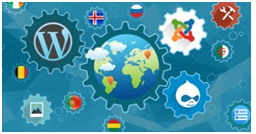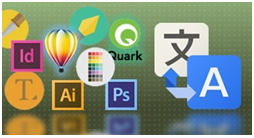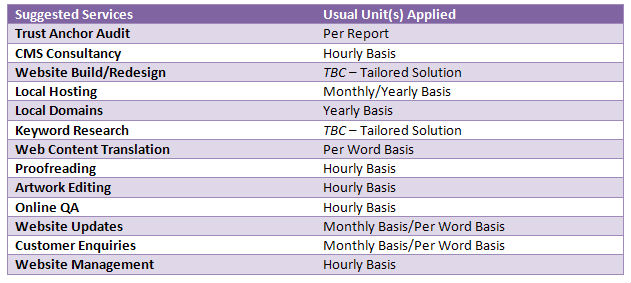As we start 2015, it is a great time to really start thinking about future projects for the next twelve months. Although you may have considered what will be included in your international marketing campaigns, and secured budget to boot, other areas might still be under discussion. So I thought now would be a good time to bring up the topic of website translation projects and the things you should consider when forming your own strategy.
Let’s get one thing clear first; website translation projects are not always straightforward! Some projects are incredibly complex, usually as a result of poor planning in the beginning, but fear not this post aims to arm you with the knowledge and the questions you will need in order to prepare your own website translation strategy.
When embarking on a web content translation project be prepared for your Language Service Provider (LSP) to ask you a lot of questions; some you may be able to answer on your own, others you may require the help from your internal IT team or external agency. In order for your LSP to provide an appropriate solution and a workflow which suits both parties, it is important for them to understand just where you stand, and the current set-up you have in place. Expect to answer questions such as:
- Are you looking at translating the whole website or do you intend to create a “microsite” for a specific country/market?
- Is the content of your website handled by a Content Management System (CMS)? If so, which one?
- How is content organised in your website?
- How frequently will your site be updated?
- Does your website also include graphics, Flash or other Rich Internet Application (RIA) content?
- What kind of encoding/characters does it support?
- What kind of server currently hosts your website?
- Do you also require search engine optimisation (SEO) of your multilingual content?
Let’s tackle each of these questions to help you understand what might be missing from your translation strategy.
What needs translating?
 Depending on the overall size of your site, and potential scope for expansion, you may only need to translate certain areas of your site rather than the whole thing. Your LSP may recommend starting small and building on this as your business grows overseas. A landing page including a contact form may suffice for a time depending on the aims you set at the beginning of the project; brand awareness for example.
Depending on the overall size of your site, and potential scope for expansion, you may only need to translate certain areas of your site rather than the whole thing. Your LSP may recommend starting small and building on this as your business grows overseas. A landing page including a contact form may suffice for a time depending on the aims you set at the beginning of the project; brand awareness for example.
If you want to go a little bigger than perhaps a microsite would be a better option. Using a few well thought out pages such as “About Us”, a couple of product pages and a contact form could allow you to start generating business in new markets. As interest increases you can add more relevant pages like expanding your product range, adding details of a local distributer or dealer etc.
Alternatively, if your business is well established in particular regions but you do not have a local website then it might be worth replicating your website in the local languages. If this option is more suited to your company, then it is important that you have a better understanding of how your website is structured, and how content can be sent for translation. The next points will cover this.
CMS
When it comes to selecting a suitable Content Management System (CMS) make sure you look into one with multilingual capabilities. Often issues can arise when using a CMS which cannot handle multilingual content, especially in the early stages of a translation project.
 If your CMS allows for plug-ins or connectors to assist in the translation workflow, then it is also worth discussing these options with your LSP as there may be solutions out there which make both of your lives easier.
If your CMS allows for plug-ins or connectors to assist in the translation workflow, then it is also worth discussing these options with your LSP as there may be solutions out there which make both of your lives easier.
Once a tailored solution has been established, then it is probably a good idea to work with your LSP to conduct a test of the system and translation workflow. Pseudotranslation is a great method of identifying where potential problems may arise during the translation process. Your LSP will take a test file exported from your site and populate this with a “fake-translation” of the content. Once this is reimported into a test version of your site both your IT team and localisation engineers can assess the performance of the test. Planning time to conduct pseudotranslations and test the workflow is definitely something you should include in your plan of action as you may come up against problems later down the line which could affect the overall turnaround time of your project.
Content organisation
An incredibly important aspect to any website translation strategy is to ensure that content is stored in a manageable way which can either be exported in a translation-friendly format, or which can be accessed via an online Translation Management System (TMS) such as Smartling for example. It is important to understand that you cannot provide your LSP with a long list of URLs and expect them to work directly in the browser; it just does not work like that!
In order to reap the benefits of Computer-Assisted Translation (CAT) Tools, your LSP will require the content to be translated to be made available. It is important whilst developing your workflow with your LSP that you think about the big picture and how content will be managed and reused throughout the longevity of your contract.
You also need to think about who will be responsible for selecting the content to be translated and pushing this through the translation workflow. It could form part of the role of one of your authors or your marketing team but either way you need to assign a project manager on your side who will liaise with your translation agency when requirements arise.
Managing updates
 Depending on the nature of your business there may be a requirement to keep your website updated with new, exciting, dynamic content. As part of your website translation strategy, it is probably worth thinking about two things:
Depending on the nature of your business there may be a requirement to keep your website updated with new, exciting, dynamic content. As part of your website translation strategy, it is probably worth thinking about two things:
- Will you replicate these updates across all language versions of your site?
- How will you manage this process?
For websites which are e-commerce heavy, it is likely that you will need to keep products up to date as they change seasonally, or you might have an active blog which needs posts localising on a weekly basis; either way you have to be sure that you know what and how such updates will be handled moving forward. Your LSP will be able to advise you on the best way to do this which will ensure a smooth translation workflow and maximising leverage across your existing Translation Memory to reduce costs and turnaround times in the long run.
Graphical content
 Across your site you might make use of lots of artwork in the form of images, banners, Flash images etc. If any of these graphics also need localising, then it is essential that you consider just how you can go about translating them. If you have the in-house capabilities to edit the artwork yourselves, then it might be a simple case of asking your LSP to extract the text to be translated and produce a bilingual table to help your graphic designers make the necessary changes. Alternatively you may want to outsource this to your LSP along with the rest of the project.
Across your site you might make use of lots of artwork in the form of images, banners, Flash images etc. If any of these graphics also need localising, then it is essential that you consider just how you can go about translating them. If you have the in-house capabilities to edit the artwork yourselves, then it might be a simple case of asking your LSP to extract the text to be translated and produce a bilingual table to help your graphic designers make the necessary changes. Alternatively you may want to outsource this to your LSP along with the rest of the project.
If you choose to outsource this work then be aware that your LSP will ask you to produce the original source files used to generate the artwork in order to minimise the level of engineering time required to recreate your images. Any artwork editing should also be included in your project plan, and reasonable time allowed for the manual work involved.
Encoding
If you are targeting regions such as Russia, China, Japan, Korea, India, UAE or Israel, then you need to make sure that your website is able to handle non-Roman character sets in order to display the translated content correctly. Ensuring that your website is set up with UTF-8 encoding will mean that all non-Roman characters can be successfully displayed. In the same respect, for languages like Hebrew and Arabic your website should also have the functionality to display text from right-to-left. It is probably best to double-check this before going ahead with translation. You could always conduct a pseudotranslation to ensure that everything is set-up correctly.
Local hosting
 In order to maximise the visibility of your international sites, once translated, you need to have an idea of how and where you want your site to be hosted. Locally hosting your site, as well as using local domains (ccTLDs), will “trick” the search engine into thinking that you are a local business, and that is just the result that you want!
In order to maximise the visibility of your international sites, once translated, you need to have an idea of how and where you want your site to be hosted. Locally hosting your site, as well as using local domains (ccTLDs), will “trick” the search engine into thinking that you are a local business, and that is just the result that you want!
Of course these are things which should be outlined in your strategy in order to cater for any technical set-up which might have to be involved in the beginning. You may require assistance from an agency who can offer local hosting, as well as involving your internal IT department or external web agency in the initial set-up of the ccTLDs etc.
Multilingual SEO
You should also consider how important SEO is to you when it comes to your multilingual websites. Building international SEO into your website translation strategy from an early stage may save you both time and money in the long-run, as well as enabling your website to start climbing SERPs as a result of incorporating local search terms and keywords. Exploring the opportunities out there prior to a project of this sort will arm you with the right questions to approach potential agencies.
Additional factors and features
Of course this is a summary of the basic things you should consider when embarking on a website translation project, but there are also other factors you should bear in mind during the briefing stage:
- Is there a shopping cart, or transactional assets, to your website?
- Are your Terms and Conditions and Privacy Policy available on your website?
- Do your visitors have the capability to contact you through your website?
Localising the shopping cart/payment area of a website does not just include translation. You also have to research the payment methods, buyer activities and Trust Anchors you will need to have in place on your site prior to launch. Conducting an Online QA via a staging platform will allow a native speaker of your target market to work their way through your localised site, pointing out any areas which need to be improved before you go ahead and push the site live.
 If you have content on your site such as T&Cs, Privacy Policy, Delivery Information, Payment Terms etc. then it is likely they will need to be localised first, adhering to local laws, and translated second by a legal translator. You may also have to consult with local authorities if drawing up new terms from scratch. Either way you need to factor these things into the time scale of your project.
If you have content on your site such as T&Cs, Privacy Policy, Delivery Information, Payment Terms etc. then it is likely they will need to be localised first, adhering to local laws, and translated second by a legal translator. You may also have to consult with local authorities if drawing up new terms from scratch. Either way you need to factor these things into the time scale of your project.
The handling of customer enquiries is one area that your business may fall short if you do not have the in-house capabilities to communicate directly with your customers in their language. Having a plan in place for this is something you should again think about during the initial stages of your strategy.
Budget and timescale
Although all of these areas should be considered during the development of a website translation strategy in order to ensure smooth workflows and delivery, and to assist in maximising your global visibility, I know how many companies out there are after a “quick and dirty” solution.
The table below provides an overview of the services which could be incorporated into your strategy and how suppliers may charge for them:
Creating an appropriate time-plan for website translation can vary greatly depending upon the stage at which you are at prior to consulting with a translation supplier. If you have to incorporate a rebuild or redesign of your site into the plan then this could extend things by as much as 18 months depending on your requirements. Translating a “monster” website can take time too so selecting the right content to translate is certainly something to think about from the beginning. If your site relies heavily on graphic content then this can also lengthen the translation process depending on the level of engineering required.
All of the points shared here are things which should really be considered prior to the development of your website, although I appreciate that you cannot always accommodate for things which you might not necessarily need in the beginning. Taking the time to plan out your strategy will be beneficial in the long-run, so I hope this arms you with the right questions to discuss internally with your team, as well as with potential suppliers when the time comes to translate your own website.










2 responses
Hi Emily, I am thankful I found your blog I just started my website and your input here would help me a lot. Thanks for sharing.
This is really a nice article. Thanks for the big help.